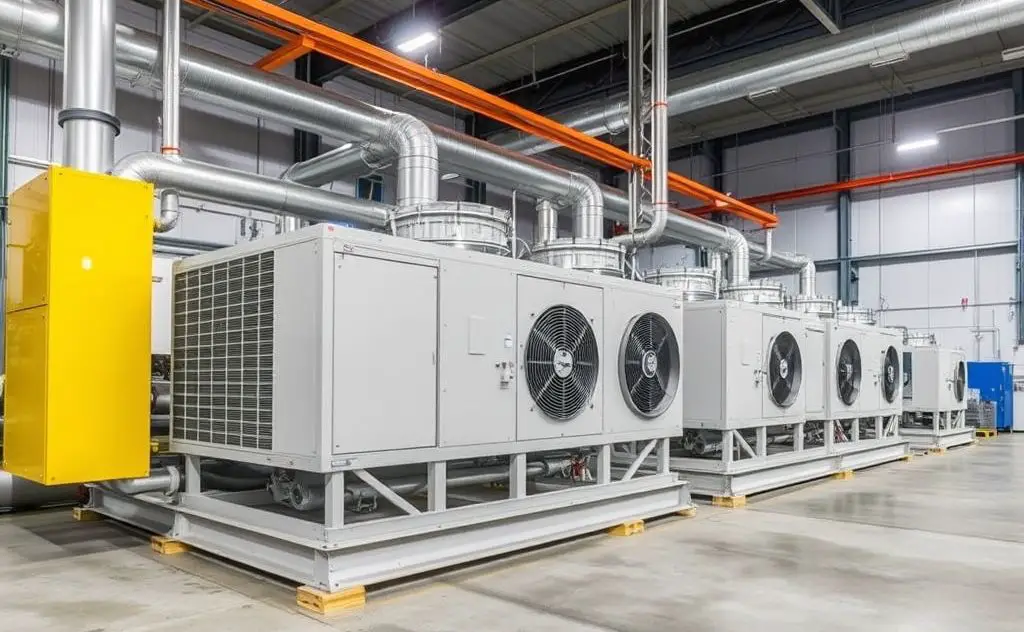To prevent overheating in industrial settings, implement proper ventilation, regular maintenance of equipment, and monitor temperature levels consistently.
Overheating in industrial environments poses serious risks to worker safety, equipment longevity, and operational efficiency. With rising temperatures and increasing regulatory requirements, facilities must implement comprehensive strategies to manage heat exposure. This guide covers proven methods to prevent overheating while maintaining productivity.

Understanding Heat Risks In Industrial Facilities
Industrial settings face unique overheating challenges due to heavy machinery, enclosed spaces, and continuous operations. The California Code of Regulations now requires specific measures when indoor temperatures exceed 82°F (27.8°C).
Primary Heat Sources In Industrial Environments
- Process heat from manufacturing equipment
- Friction from moving mechanical parts
- Electrical system inefficiencies
- Compressed air systems
- Poor ventilation in confined spaces

Engineering Controls For Heat Prevention
Effective heat management begins with engineering solutions that address the root causes of excessive temperatures.
Ventilation Systems
Proper airflow is critical for heat dissipation. Consider these options:
| System Type | Best For | Effectiveness |
|---|---|---|
| HVAC Systems | Climate-controlled areas | High |
| Industrial Fans | Open work areas | Moderate |
| Exhaust Ventilation | Point source heat removal | High |
For specialized heating equipment, consider industrial heater blowers that can be adjusted for optimal airflow.
Equipment Cooling Solutions
Machinery generates significant heat during operation. Implement:
- Liquid cooling systems for high-heat equipment
- Thermal insulation on hot surfaces
- Scheduled maintenance to ensure efficient operation
- Heat-resistant materials for components
Administrative Controls And Work Practices
Beyond physical modifications, operational changes can significantly reduce heat stress.
Work/Rest Cycles
The California OSHA standards recommend:
- 15-minute cool-down breaks every 2 hours at 82-87°F (27.8-30.6°C)
- 30-minute cool-down breaks every 2 hours above 87°F (30.6°C)
- Mandatory breaks in designated cool areas below 82°F (27.8°C)
Hydration Strategies
Proper hydration is essential for heat illness prevention:
- Provide cool (50-60°F/10-15.5°C) drinking water every 15 minutes
- Locate hydration stations within 100 feet of work areas
- Encourage drinking before feeling thirsty
Personal Protective Equipment (PPE)
Specialized gear can help workers manage heat exposure while maintaining safety.
Cooling PPE Options
- Phase change cooling vests
- Evaporative cooling bandanas
- Breathable, moisture-wicking fabrics
- Cooling hard hat liners
For outdoor-indoor transition areas, consider indoor propane heaters that provide warmth without excessive radiant heat.
Monitoring And Emergency Preparedness
Proactive monitoring prevents heat-related incidents before they occur.
Temperature Monitoring Systems
Implement:
- Real-time temperature sensors throughout the facility
- Wet bulb globe temperature (WBGT) monitoring for comprehensive heat stress assessment
- Automated alerts when thresholds are exceeded
Emergency Response Planning
Prepare for heat emergencies with:
- Designated first aid responders trained in heat illness recognition
- Cooling stations with misting fans and cold compresses
- Emergency communication protocols
- Evacuation routes for extreme heat events
According to Cal/OSHA guidelines, employers must provide immediate medical attention for any worker showing signs of heat illness.
Maintenance For Heat Prevention
Regular equipment upkeep prevents unnecessary heat generation.
Key Maintenance Practices
- Monthly inspection of all cooling systems
- Quarterly cleaning of ventilation ducts
- Annual thermal imaging of electrical systems
- Prompt repair of malfunctioning equipment
For facilities with water heating systems, precise thermostat control can prevent overheating while maintaining necessary temperatures.
Training And Education
Comprehensive training ensures all personnel understand heat risks and prevention methods.
Essential Training Components
- Recognizing heat illness symptoms
- Proper use of cooling equipment
- Hydration requirements
- Emergency procedures
As noted in industrial safety resources, proper training reduces heat-related incidents by up to 70%.
